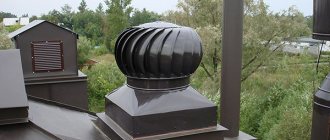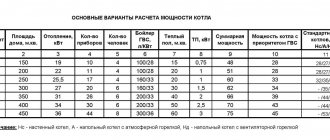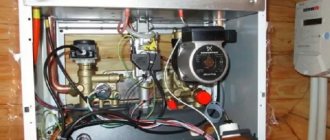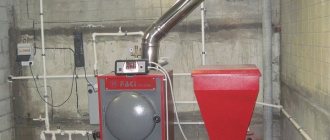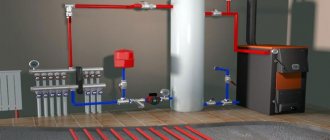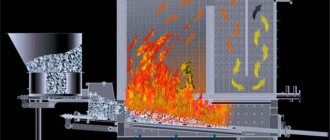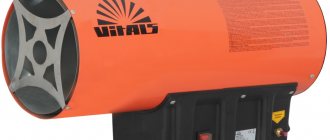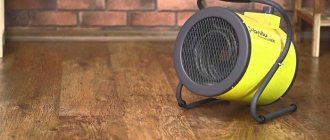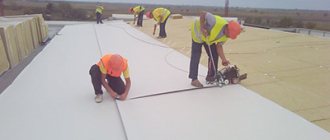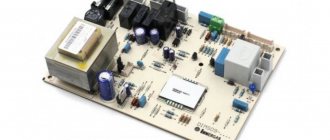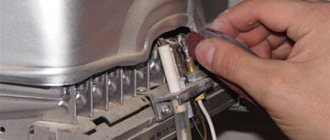For smoke removal in modern conditions, not only ventilation is used, but also other design options created specifically for these purposes. A smoke exhauster, for example, is a fan that creates a powerful air flow and removes from the room all the harmful accumulations that are present in it.
Diagram of the smoke exhauster-dust collector: 1 – drive shaft, 2 – wheel, 3 – clean gas volute, 4 – pipe, 5 – inlet volute, 6 – additional impeller, 7 – control damper, 8 – cyclone, 9 – pipe, 10 – dust gate, 11 – chimney, 12 – bunker.
Today, such devices have found application not only in everyday life, but also in industry. They are often used in boiler houses that run on solid fuel. This is worth talking about, but a little later.
The most important thing is to understand why such a fan is needed and how it works. Today there are several modifications of it, which differ in characteristics, size and shape. However, despite this, the smoke exhaust device is the same in all configurations.
Main components of the smoke exhauster
Today, the smoke exhauster is a centrifugal fan, which consists of a limited number of parts and assemblies. They all have their own purpose. So, such a fan consists of:
Block diagram for a smoke exhauster.
- Snails. This is a kind of casing, which really resembles this simple insect in its structure. The snail is created in a special way from metal. It is in it that vortex air flows will circulate. This housing allows the unit to operate as efficiently as possible.
- Impeller. It is sometimes called squirrel. Indeed, its design resembles where this animal runs. This wheel consists of two plates. The first one is mounted on the shaft. A bushing is provided here for these purposes. The second plate is used to fasten the blades, that is, metal plates. They have a certain bend angle, which is done specifically to ensure that the air flow works as efficiently as possible.
- Electric motor. This element is the main one for any fan. This also applies to the smoke exhaust device. Today, a wide variety of engine types are used in industry. As for the smoke exhauster or fan, it is best to use asynchronous models. They are capable of operating for a long time on a three-phase power supply. In addition, such units are not that expensive.
Today it is not difficult to purchase them. They are distributed by many specialty stores. Of course, it is best to use smoke exhausters that have the ability to adjust engine rotation. For these purposes, an asynchronous three-phase motor can be equipped with special devices that can have both linear and nonlinear characteristics. Everything depends directly on the specific case.
Right-hand rotation smoke exhausters.
Of course, when installing a fan or smoke exhauster that has high power ratings, additional protection must be connected. In this case, the use of an automation system is implied. It is best if a separate circuit breaker is connected to the panel, which will turn off the motor in the event of an unforeseen situation.
The electric motor is thus protected from many unfavorable factors. Automatic machines are selected depending on engine power. In this case, their current strength should exceed the original smoke exhauster by several percent. Today, such protection devices are used everywhere. They allow you to save the unit if a short circuit or breakage of one of the working phases occurs.
Calculation of ventilation. The principle of computer fan control. How do smoke exhausters work? More details>>
Main differences between the devices
Smoke exhausters for household solid fuel boilers are most often used. This is due to the fact that when fuel burns, in addition to gaseous waste, there are also solid particles that settle on the inner walls of the chimney. This leads to the need to periodically take on the role of a chimney sweep and clean the system so that it does not lose its functional qualities. And when using forced release of waste into the atmosphere, such an operation will have to be done much less frequently.
The smoke exhauster for a pyrolysis boiler is less in demand, since this element has a slightly different operating pattern. In it, after the combustion of solid fuel, an additional process of re-combustion of gaseous waste occurs. Therefore, emissions into the atmosphere here will be much less than usual. And the less smoke, the easier it is to remove it.
But in order to improve the quality of the heating system, you can install such an upgrade. This should be done only if necessary and if you have enough money, since such a pleasure will not be cheap.
For obvious reasons, electric heating systems do not require such devices, since they do not have a chimney at all. But for a gas boiler, a smoke exhauster can be useful. This is especially true for apartments, since there is no possibility of vertical installation of communications for smoke removal. Therefore, in such conditions, forced exhaust is always used. It is very important to ensure not only a comfortable temperature level in the rooms, but also complete safety for all residents. And this can only be achieved if the heating system is properly equipped with the elements necessary for operation.
There are many different types of fans for forced removal of gases on the market. Selecting a smoke exhauster for a boiler begins with studying its technical characteristics. Without this stage, none of the next ones makes sense. You need to carefully study all operating parameters to find a suitable model. Then you can look at the manufacturer and other related issues.
The price of smoke exhausters for a boiler is several thousand rubles. It all depends on the dimensions and maximum traction power. But for domestic needs, huge fans that cost tens of thousands and are used in industrial production will not be required.
Some characteristics of the frame
It is most often made of metal. This unit is not standard. If necessary, you can even change its shape so that you can easily attach the fan to any base. The frame may be missing.
Device of a “cold” smoke exhauster.
It all depends on the specific design of the smoke exhauster. They can be mounted in a non-standard way. In this case, everything directly depends on the specific project. There are 6 working schemes in total. Each of them is actively used in practice.
The execution system also affects other components of the unit. They can be additionally equipped with a bearing shaft or a belt drive. Often, manufacturers leave the choice of a specific option to the buyer. If necessary, he can add any working scheme with his innovations.
The principle of calculating the power of the smoke exhauster
If there is insufficient traction, experts will advise making appropriate calculations to understand how the situation can be corrected. When choosing a solution in favor of a special device, you will also have to organize a calculation of the power of the smoke exhauster for the boiler. This will not be difficult to do, especially since all the formulas have long been derived and tested in practice. Then all that remains is to select a device that matches the obtained parameters.
Forced ventilation for the heating system will make the following improvements:
- — increase the efficiency of the boiler;
- — fuel consumption required to generate a kilowatt of energy will be reduced;
- — draft will improve and combustion products will not enter living quarters;
- - you don’t have to redo the chimney or modernize it.
These improvements apply to any heating system, regardless of its type.
Why do you need a smoke exhauster?
So, everything is clear with the fan structure. Now we can talk in more detail about the purpose of the smoke exhauster. In fact, there are several smoke exhausters, because such a device is universal. They are installed in almost all areas of heating systems.
Diagram of body rotation angles.
Smoke exhausters occupy a central place in almost all boiler rooms. This is due to their structure and properties. Of course, such units, which have low power, can also be used in industrial enterprises.
Equipment of this type is installed not only on large, but also on small water heating boilers. They can be used in almost all types of boiler rooms known to mankind. However, the work of smoke exhausters is not limited to this area. Due to their versatility, they can be used in other sectors of the national economy where it is necessary to remove smoke from a room or from units.
Design
Let's look at the design of a smoke exhauster using the example of a DN product (in the diagram).
Main parts of the structure:
- welded volute body
- Working wheel
- axial guide vane of the smoke exhauster (SHA)
- electric motor
- pedestal frame
The impeller consists of two disks (main and front), 16 curved blades and a hub. The accuracy class for balancing the smoke exhaust fan impeller (GOST 22061) is fourth.
The welded body has a snail shape and consists of a shell and two side walls. When installing the unit, the volute can be mounted with the required angle of rotation (see figure).
The guide apparatus of the smoke exhauster is located at the inlet of the flow, and consists of a cylindrical body, a rotary ring, and 8 sheet blades. The blades are connected to the turning ring through a system of levers.
Device Features
Basically, all smoke exhausters that are present on the modern market can be produced in two versions, namely right and left rotation. In some situations, it can be quite difficult to determine which way the wheel is turning. However, any specialist can cope with this task.
First you need to approach the unit from the engine side. From here you should be able to see in which direction the impeller rotates. Left rotation is counterclockwise, and right rotation is clockwise. The angle of rotation of the snail can be varied. It varies from 0 to 270°. The rotation interval is – 15°.
Installation diagram of the smoke exhauster.
So, determining the direction of rotation is quite simple. Sometimes there are cases when, during an incorrect connection, the unit begins to work incorrectly, that is, it does not pull smoke out of the room, but drives in all the worst things from the environment. This is simply unacceptable. This problem can be solved quite simply. It is worth switching the phases either on the circuit breaker or directly on the motor. That is, you simply need to swap them.
Sometimes stiffening ribs interfere with the operation of smoke exhausters. In this case, some of them can simply be deleted. This is done mechanically.
Visual inspection and maintenance of the units must be carried out through special hatches or openings located on the volute. During operation, condensation may accumulate in the fan. Of course, you need to get rid of it immediately. Fortunately, the design of modern units provides for the presence of special drain holes on the volute. Excess moisture is removed through them.
If large bearings are installed in the smoke exhauster, then it will serve faithfully for many years.
Smoke exhauster impeller.
The wear and tear of such units is insignificant. Often, collapsible bearings are used in such smoke exhausters. This is done to ensure that their maintainability is at its best. Large units are quite difficult to work with, but if they are understood, then this will not be a problem.
Some smoke exhausters or fans get quite hot. This also applies to large units. In this case, they can be equipped with an additional cooling coil. Today, many manufacturing companies offer this additional option.
Operation of the smoke exhauster
To switch the operating mode, the fan has guide devices that change the aerodynamic characteristics of the smoke exhauster. Thanks to this, efficiency increases significantly and energy losses are reduced.
During operation, the fans may get dirt and foreign objects, which will lead to fan failure. Therefore, smoke exhausters are equipped with suction pockets that can trap solid debris.
Types of smoke exhausters
All these devices can be classified into groups according to several criteria:
- The first type of smoke exhauster is smoke exhauster D. In the design of this chimney, the impeller is located directly on the shaft of the propulsion motor. This device belongs to the group of small-sized structures.
- The second type of draft machines is the DN smoke exhauster. In this case, the impeller is also mounted on the motor shaft, however, despite this similarity, the structures of chimneys of the DN group are considered to be of higher quality, since the power of its drive will be much greater than that of chimneys of the first type.
The following three types of chimneys are combined into one large group of fire chimneys:
- DPE chimney (fire electric smoke exhauster). This device has one important advantage: the DPE smoke exhaust engine runs on electricity and is portable. The type of engine can also vary: it can be centrifugal, axial turbocharged, centrifugal mobile or axial turbocharged mobile.
- The second type of chimneys are DPM smoke exhausters. These devices for the furnace have a portable motor engine; it can also be of different designs, namely: a centrifugal fire engine or an axial turbocharged fire engine.
- The third type of draft machines are devices for trailed-type furnaces (DP smoke exhausters). These furnace units have several main characteristics, now we will list them: productivity;
- pressure (pressure).
During operation of trailed-type draft machines for furnaces, the main limitations of the machines are:
- The manufacturer indicates the value that is the maximum permissible temperature for all gases. This value must not be exceeded when using the oven.
- The manufacturer also indicates the maximum permitted level of dust, dirt and other solid substances.
Principle of operation
By their type, blower fans and smoke exhausters are centrifugal machines, therefore their operating principle is similar to the operating principle of centrifugal pumps. They work as follows. The rotation of the motor drives the impeller. Rotating, the latter creates a vacuum in the center, under the influence of which air or flue gases are drawn through the suction pipe into the pump housing. Thrown by the wheel blades to the periphery, it flows through the spiral casing into the discharge pipe, creating increased pressure in it.
Depending on the type of fuel being burned, the blower fan discharge pipe is connected to the burner (if heating is produced by gas or liquid fuel) or to the primary air supply input to the boiler - under the grate (if solid fuel is used). Passing through the ash and combustion chamber, the air supplies the firebox with a sufficient amount of oxygen necessary for complete combustion of the fuel.
Fans (smoke exhausters) are designed for operation at outside temperatures of -40… +40 °C. The permissible temperature of pumped gases for fans depends on the modification and is -30...200 °C (for VD models) or -30..80 °C (for VDN). Operation of smoke exhausters is allowed at temperatures of exhausted gases up to 250 °C.
Smoke exhausters and blower fans should not be used for pumping explosive and aggressive gas-air media, mixtures that are highly dusty, and/or containing adhesive, fibrous or abrasive substances.
Main characteristics
The main characteristics that determine the operation of a centrifugal fan are:
- performance, that is, the ability of the fan to pump a certain amount of gas-air mixture per unit of time, m³/hour;
- total pressure, the pressure created by the fan at its outlet, taking into account the pressure at the inlet.
Fan selection
A blower fan is selected with a lower capacity than a smoke exhaust fan, since the amount of combustion products exceeds the required amount of supplied air, and the boiler furnace must be under vacuum (the draft created by the smoke exhauster exceeds the excess pressure created by the blower fan. The choice of a fan for smoke exhaust depends on the power of the boiler with which it will be used to be used, depending on the cross-section and length of the chimneys, and the type of fuel used in the boiler plant.
Options for draft machines
There are 5 design options for draft machines, depending on the installation diagram (method of connection to the engine, type of frame and base). In some cases, a vibration base is used to reduce vibration. Features of the wiring diagram for each version are shown in the table below.
| Execution | Working wheel | Frame | Base | Suction |
| 1 | Mounted on shaft | Engine frame or general | Normal | Unilateral |
| 2 | a) Installed on the motor shaft b) Installed on the intermediate shaft (bearing unit) | a) Single with the engine b) Common base (pedestal) | Vibration base | Unilateral |
| 3 | Installed on the intermediate shaft (bearing unit) | a) Separate (separate for motor and fan) b) Single a) Common base (pedestal) | Normal | Unilateral |
| 4 | Impeller with forward curved blades | Separate for motor and fan | Normal | Bilateral |
| 5 | Impeller with radial or backward curved blades | Separate for motor and fan | Normal | Bilateral |
When should you buy a smoke exhauster?
Heating equipment has its own fans, which are needed due to the high resistance of the heat exchanger - the gas changes the direction of its path in the flame tubes. A fan is installed to remove heat from combustion products and increase the efficiency of the heating device.
The forced exhaust that comes with the boiler is configured for combustion in this equipment and is controlled from the remote control. If a fan is installed on a device without a computer, then their operation will not be synchronized.
To coordinate the work, you need to buy automation or set the speed yourself.
In what cases is a smoke exhauster necessary to improve operation and simplify boiler maintenance:
- if there are problems with draft, when the wind blows, air pockets appear, there are many turns in the chimney, the diameter narrows;
- smoke from the boiler enters the room when the door is opened;
- the chimney is low or the top of the chimney is in the area of wind pressure, covered by another building or ridge;
- there are cracks in the brick pipe through which smoke escapes.
It is useless to buy a smoke exhauster if there is no air flow from outside. Immediately after installation, the wings will discharge the air a little, but then they will simply knead it in place.
Air supply is the key to proper operation of the heating installation.
Some solid fuel boilers may release smoke through the loading door when it is open. The same phenomenon can be seen in three-pass heating systems in fire tube heat exchangers with high resistance.
There is only one solution - install a smoke exhauster with automatic control or normalize the draft.
There is also a disadvantage to installing forced ventilation. If a chimney hood is not installed, the device cannot be turned off, otherwise carbon monoxide will accumulate in the room.
This is dangerous in the event of an unexpected power outage.
Therefore, forced ventilation is not forever; it should not replace natural draft, but only help in cases where something interferes with it. Therefore, if there are difficulties, the causes of interruptions in traction should be eliminated.
Features of using smoke exhausters
When choosing a traction smoke exhauster, you need to calculate the cross-section of the exhaust pipe and the power of the exhaust unit. Unlike pressure units, they are more versatile and efficient, they allow you to add firewood while the boiler is operating, and prevent combustion products from entering the room.
Forced exhaust of combustion products will help make your stay in the room safe and reduce the risk of carbon monoxide poisoning to a minimum.
The use of smoke exhausters for pellet burners or boilers running on sawdust or peat is the only possible way to organize the heating process. Under normal conditions they burn poorly.
Advantages of using a chimney hood:
- Improving the efficiency of heating devices, firewood burns with virtually no residue;
- Eliminates the accumulation of smoke in rooms, eliminates unpleasant odors;
- Exhaust gases do not flow back into the room when the firebox door is open;
- Reduce deposits on the walls of chimneys due to the filtration and separation system.
They have practically no disadvantages. If no errors were made during installation, the service life of the smoke exhauster in the chimney is comparable to the service life of the boiler itself. In this case, regular maintenance must be carried out.
Why install a smoke exhauster?
The correct and durable service of the heating device, its efficiency and the normal microclimate in the room depend on a high-quality chimney and good draft. Complete exhaust gas removal, that is, an effective smoke removal system, ensures complete combustion of fuel and maximum efficiency. All technical nuances of the design and construction of chimneys are aimed at obtaining excellent draft. It must be sustainable and sufficient.
And traction occurs when there is a temperature difference. According to the laws of physics, the hot air from the firebox rushes upward, taking with it the smoke and soot that are formed during combustion. In modern wood-burning boilers, the mode can vary from sub-zero temperatures to plus 350 degrees. And at the same time there should always be excellent air movement in them. Natural traction in such conditions may not be enough. This is how separate draft amplifiers, or smoke exhausters, were invented. They acquired particular importance with the advent of modern high-efficiency boilers, which are more capricious and demanding.
The main reason for installing a smoke exhauster is that the horizontal section of the transition from the boiler to the chimney is too long. Most often this happens due to thick walls. One and a half meters of horizontal section is bad for any boiler or stove. Smoke does not like to travel through horizontal channels, and in the case of high-efficiency boilers (such as pyrolysis boilers, for example), this situation can lead to an almost complete absence of draft.
